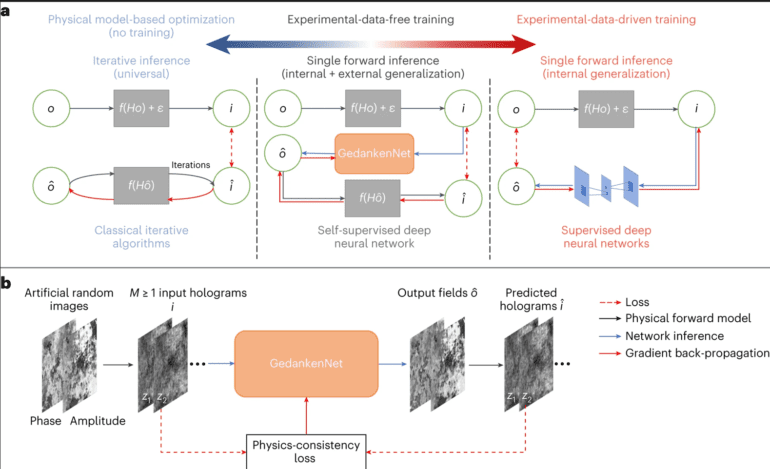TL;DR:
- Recent deep learning advancements reshape computational imaging and microscopy.
- GedankenNet introduces self-supervised learning through a physics-consistent approach.
- Overcomes limitations of labeled and experimental data in hologram reconstruction.
- The architecture employs Spatial Fourier Transformation blocks for enhanced spatial understanding.
- Physics-consistency loss ensures accurate complex field outputs, surpassing traditional methods.
- GedankenNet excels in hologram reconstruction, mitigating artifacts and defocused samples.
- UCLA’s GedankenNet pioneers versatile and physics-compliant deep learning models.
- Accelerates microscopy advancements, opening doors for broader applications.
Main AI News:
The realm of computational imaging, along with its applications in microscopy, holography, and related fields, has witnessed a transformative shift thanks to recent strides in deep learning. These advancements have ushered in a new era of possibilities, empowering technologies that span biomedical imaging, diagnostics, sensing, and three-dimensional displays. Within this landscape, the potency of deep learning models stands out as they adeptly handle image enhancement, translation, super-resolution, denoising, and virtual staining tasks. These models seamlessly integrate with various imaging modalities, from fluorescence microscopy to bright-field techniques, redefining our capacity to fathom the intricacies of the microscopic world.
Conventionally, the arena of computational imaging has leaned on supervised learning paradigms, entailing substantial datasets adorned with annotations or meticulously gathered experimental images. Such models pivot on labeled training data extracted through diverse means, spanning classical algorithms to meticulously aligned image pairs hailing from distinct imaging modalities. However, this approach grapples with limitations, encompassing the arduous process of acquiring, aligning, and preprocessing training images and the possible instigation of inference bias. Even in the face of attempts to circumvent these constraints via unsupervised and self-supervised learning, a reliance on experimental measurements or sample labels remains prevalent. While certain endeavors have turned to labeled simulated data for training, the faithful representation of experimental sample distributions remains intricate, necessitating a profound grasp of sample characteristics and imaging configurations.
Responding to these intrinsic challenges, visionaries from the UCLA Samueli School of Engineering introduce GedankenNet—an audacious innovation fostering a revolution in the realm of self-supervised learning. Distinctively, GedankenNet departs from the conventional, eliminating the necessity for labeled or experimental training data and bearing no semblance to real-world samples. Through training anchored in physics laws and artificial random images, this groundbreaking approach surmounts the obstacles confronting prevailing methods. It ushers in a novel paradigm for hologram reconstruction, offering a promising panacea to the limitations inherent in supervised learning techniques frequently wielded across various microscopy, computational imaging, and holography pursuits.
The architecture of GedankenNet hinges on a constellation of Spatial Fourier Transformation (SPAF) blocks, intricately interlinked via residual connections. This ingenious design adeptly assimilates spatial and frequency domain information. By imbibing a physics-consistency loss function, the model imposes fidelity to the wave equation during hologram reconstruction, culminating in complex field outputs that faithfully adhere to physical laws. This unique training modality empowers GedankenNet with the capacity to transcend boundaries, seamlessly accommodating synthetic and experimental holograms, even when grappling with uncharted samples, axial defocus, and fluctuations in illumination wavelength.
A meticulous evaluation of GedankenNet’s performance underscores its prodigious prowess in hologram reconstruction. Quantitative metrics, such as the Structural Similarity Index (SSIM), Root Mean Square Error (RMSE), and Error Correction Coefficient (ECC), spotlight GedankenNet’s steadfast superiority over traditional supervised methodologies across an extensive array of holograms. Particularly noteworthy is the model’s adeptness in quelling non-physical artifacts through its physics consistency loss, resulting in reconstructions that are both sharper and more precise. The model’s harmony with the wave equation bolsters its efficacy, enabling it to reclaim object fields of unparalleled quality from defocused holograms via accurate wave propagation. These revelations underscore GedankenNet’s supremacy in external generalization, equipping it to master novel experimental data and phase-only samples with unparalleled faithfulness.
In totality, GedankenNet—a brainchild of the UCLA research team—stands as an epochal leap within the dominion of computational imaging and microscopy. Embracing the potent union of self-supervised learning and thought experiments deeply rooted in the bedrock of physics, GedankenNet presents an invigorating approach to nurturing neural network models. This inventive methodology not only dismantles the barriers of extant supervised learning techniques but also lays the groundwork for more adaptable, physics-congruent, and effortlessly trainable Deep Learning models to cater to an array of computational imaging tasks. This watershed moment has the potential to expedite advancements in microscopy, paving the way for expansive applications and profound insights into the microcosmic expanse.
Conclusion:
The introduction of GedankenNet marks a significant leap in the field of computational imaging. By capitalizing on self-supervised learning grounded in physics principles, GedankenNet redefines training neural network models. This innovation not only transcends the limitations of traditional supervised methods but also ushers in a new era of adaptable and physics-congruent Deep Learning models. This breakthrough is poised to expedite progress in microscopy, unlocking a realm of applications and insights previously unattainable. The market can anticipate a surge in versatile imaging technologies, fueling advancements and deeper understandings across various sectors.

